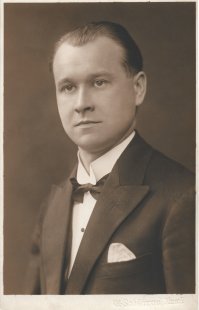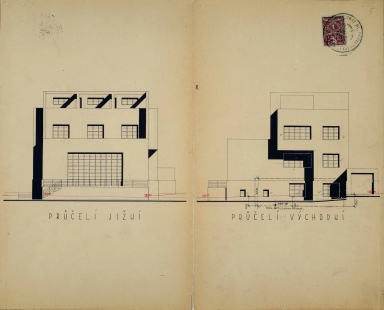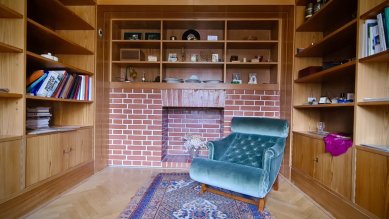
Loos Forever - exhibition at the Winternitz Villa
Source
Winternitzova vila
Winternitzova vila
Publisher
Tisková zpráva
02.12.2020 23:10
Tisková zpráva
02.12.2020 23:10
Exhibitions
Czech Republic
Prague
Smíchov
Adolf Loos
Karel Lhota
Open: Sunday to Wednesday 12-6 PM
The exhibition "Loos Forever" at the Winternitz villa is held on the occasion of the 150th anniversary of the birth of architect Adolf Loos. More than just a classic exhibition, it is rather a kind of space for encounters with Adolf Loos, his thoughts, inspiration, his friends, and collaborators (especially his co-author of the Winternitz villa, Karel Lhota) in his last realized building. You can sit in the armchair he used, read his book of essays undisturbed, listen to the music that inspired him, and absorb Adolf Loos's work with all your senses.
Adolf Loos, originally from Brno, is today considered one of the pioneers of modern architecture who was not afraid to swim against the tide and the conventions of his time. The exhibition, besides showcasing his architectural work, also addresses lesser-known aspects of his life and reminds us that Loos was, among other things, an excellent essayist and a very influential teacher. He was also very sociable and had many interesting friends, clients, students, and collaborators during his lifetime, but due to his nature, he also had quite a few opponents.
Among Loos's last collaborators was Czech architect Karel Lhota, with whom he designed the Winternitz villa, as well as several other projects including the famous Müller villa. Lhota is not very well known today; however, his contribution to Loos's later buildings is fundamental, which is why the exhibition also focuses on him.
The exhibition is scattered throughout the Winternitz villa, which itself is the largest exhibit. The opportunity to organize an exhibition about Adolf Loos and Karel Lhota directly in their last joint work gives visitors the chance to personally explore what they read about in the exhibition texts. "The exhibition is arranged so that the visitor walks through the house, finds rooms containing panels with texts, photographs, artifacts commemorating the lives of both architects, as well as books that are in some way related to them. The exhibition is designed to present both architects and their work without overwhelming the viewer, but rather to enhance the experience in an unusual way. For example, visitors can sit in the chairs and read the books without restrictions, allowing them to absorb the thoughts and work of Adolf Loos with all their senses," describes the "homely" atmosphere of the exhibition, its curator Daniel Verner.
"The exhibition also includes two rooms with a new permanent exhibition dedicated to the Winternitz villa itself and to the family of my great-grandfather, Josef Winternitz, who lived in the villa but was later deprived of it due to his Jewish origin, and whose fate was profoundly marked by both the Holocaust and communism," adds David Cysař, director of the Winternitz villa.
Winternitz Villa
The villa was built in 1932 for lawyer JUDr. Josef Winternitz by Adolf Loos and Karel Lhota as a family home for his wife Jenny, daughter Suzanna, and son Petr. It is Loos's last completed building, finished shortly after the famous Müller villa, with which it shares several elements - including the layout method (the so-called Raumplan), which was generally characteristic of Loos. Since October 2018, the villa has been included in the international network of famous houses of the world, Iconic Houses. The villa can be visited from Sunday to Wednesday between 12 PM and 6 PM without reservation, and every Saturday and Sunday as part of guided tours. Visitors can not only view the work of Adolf Loos, explore the current exhibition, and the permanent exhibition tracing the villa's fate since the 1930s, but also enjoy the unique spaces during some of the accompanying programs. Josef Winternitz's great-grandson David Cysař and his wife Kristina host lectures devoted to the history of art and architecture, theater, concerts, swing dance parties, and other cultural events in the spirit of the salons of the 1930s. A homely family atmosphere is typical for these events. Overnight stays are also possible, allowing guests to experience how life was in the villa, rest on the terrace, or peacefully observe the house from the garden while reading.
The exhibition "Loos Forever" at the Winternitz villa is held on the occasion of the 150th anniversary of the birth of architect Adolf Loos. More than just a classic exhibition, it is rather a kind of space for encounters with Adolf Loos, his thoughts, inspiration, his friends, and collaborators (especially his co-author of the Winternitz villa, Karel Lhota) in his last realized building. You can sit in the armchair he used, read his book of essays undisturbed, listen to the music that inspired him, and absorb Adolf Loos's work with all your senses.
Adolf Loos, originally from Brno, is today considered one of the pioneers of modern architecture who was not afraid to swim against the tide and the conventions of his time. The exhibition, besides showcasing his architectural work, also addresses lesser-known aspects of his life and reminds us that Loos was, among other things, an excellent essayist and a very influential teacher. He was also very sociable and had many interesting friends, clients, students, and collaborators during his lifetime, but due to his nature, he also had quite a few opponents.
Among Loos's last collaborators was Czech architect Karel Lhota, with whom he designed the Winternitz villa, as well as several other projects including the famous Müller villa. Lhota is not very well known today; however, his contribution to Loos's later buildings is fundamental, which is why the exhibition also focuses on him.
The exhibition is scattered throughout the Winternitz villa, which itself is the largest exhibit. The opportunity to organize an exhibition about Adolf Loos and Karel Lhota directly in their last joint work gives visitors the chance to personally explore what they read about in the exhibition texts. "The exhibition is arranged so that the visitor walks through the house, finds rooms containing panels with texts, photographs, artifacts commemorating the lives of both architects, as well as books that are in some way related to them. The exhibition is designed to present both architects and their work without overwhelming the viewer, but rather to enhance the experience in an unusual way. For example, visitors can sit in the chairs and read the books without restrictions, allowing them to absorb the thoughts and work of Adolf Loos with all their senses," describes the "homely" atmosphere of the exhibition, its curator Daniel Verner.
"The exhibition also includes two rooms with a new permanent exhibition dedicated to the Winternitz villa itself and to the family of my great-grandfather, Josef Winternitz, who lived in the villa but was later deprived of it due to his Jewish origin, and whose fate was profoundly marked by both the Holocaust and communism," adds David Cysař, director of the Winternitz villa.
Winternitz Villa
The villa was built in 1932 for lawyer JUDr. Josef Winternitz by Adolf Loos and Karel Lhota as a family home for his wife Jenny, daughter Suzanna, and son Petr. It is Loos's last completed building, finished shortly after the famous Müller villa, with which it shares several elements - including the layout method (the so-called Raumplan), which was generally characteristic of Loos. Since October 2018, the villa has been included in the international network of famous houses of the world, Iconic Houses. The villa can be visited from Sunday to Wednesday between 12 PM and 6 PM without reservation, and every Saturday and Sunday as part of guided tours. Visitors can not only view the work of Adolf Loos, explore the current exhibition, and the permanent exhibition tracing the villa's fate since the 1930s, but also enjoy the unique spaces during some of the accompanying programs. Josef Winternitz's great-grandson David Cysař and his wife Kristina host lectures devoted to the history of art and architecture, theater, concerts, swing dance parties, and other cultural events in the spirit of the salons of the 1930s. A homely family atmosphere is typical for these events. Overnight stays are also possible, allowing guests to experience how life was in the villa, rest on the terrace, or peacefully observe the house from the garden while reading.
The English translation is powered by AI tool. Switch to Czech to view the original text source.





0 comments
add comment











